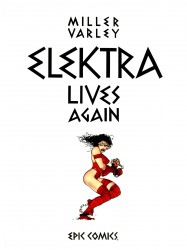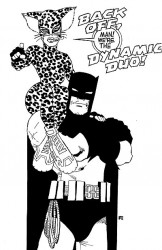
Booze, Broads, & Bullets: Elektra Lives Again
April 12th, 2010 Posted by david brothersGo read Chad Nevett on Sin City: The Hard Goodbye. I’ll wait. Promise. I got plenty of booze and broads right here, but the bullets are in my other jacket pocket. Index of posts here.

Elektra Lives Again
Why is this book significant? It was Miller’s first stab at the character since 1986’s Elektra Assassin with Bill Sienkiewicz. Miller has admitted that his writing that book adjusted the way he approaches making comics due to the back and forth and explosion of ideas between Miller and Sienkiewicz.
Elektra Lives Again comes after that, and after that time Miller dropped four classics between 1986 and 1987. Nearly ten years had passed since his run on Daredevil began. Elektra Lives Again, like Dark Knight Strikes Again ten years later, was Frank Miller coming home again, going back to what made him a name.
Like Ronin, Elektra Lives Again is on another level visually. While all comics are group efforts, this is one of those that simply wouldn’t be the same without Varley’s painted colors. Miller is credit with script and line art, which I assume means that he inked himself. Most of the definition and shading seems to be courtesy of Varley, whether it is the diseased flesh of the zombies who hunt Elektra or Murdock’s feverish face while he dreams.
Ronin had a palette that brought to mind decaying organics and broken futures. This book, on the other hand, has a subdued palette. Even scenes that are lit by flames are dark and dreary, perfectly reflecting Matt Murdock’s mental state. Lynn Varley counts, though most of what i’m about to say is about Miller in particular.






There is a sequence of pages in this book that I’m in love with. It is the first of perhaps three major action scenes, and begins after Murdock has tried to heal his pain through sex with a client. It didn’t work, and he calls it “a sad thing.” He goes walking in his underwear, wrapped up his own thoughts, and ends up at her grave. Ninjas attack, demanding to know where Elektra is, and then Elektra rises from the ground, literally rising from her grave, and laying waste to the ninjas. Murdock and Elektra meet face-to-face, neither speaking, before Elektra makes her getaway.
It’s standard when spelled out, but the execution is obscenely beautiful. Miller lays out the page with enormous panels, generally two to a page and stacked vertically. They are packed with detail, whether that’s the intricate brickwork on Murdock’s brownstone, the constantly shifting graveyard, or the various weapons the ninjas use while attacking. Miller keeps the camera in motion during the fight, zooming in or out as needed, while leaving the background fluid.
But the mind-blowing part, the part I keep coming back to, is page twenty-three. Murdock hops off his railing, lands on a wire, and bounces to a rooftop. Anyone who has read a Batman, Spider-Man, or Daredevil comic knows it well, but I bet you’ve never seen it rendered like this. Matt’s form is practically angelic as he comes off his railing, and the only hint that he is in motion is the splash of snow he left behind.
He hits the wire and we capture a perfect moment between moments. Murdock is still in the process of landing on the wire, a split-second before his muscles shift and he launches himself upward to his next perch. In that split-second, we see that the snow that rested on the wire is still in mid-air, and he’s split it perfectly.
This is poetry in motion, one of those scenes that makes you pause and marvel. There’s a later page that is almost as amazing. Page 30 features Elektra pausing and then punching through a ninja as his momentum carries her off the hill. It’s great, but panel two, page twenty-three is king. It has a message, and that message is this: Frank Miller knows exactly what he is doing, and he is very good at what he does.
Look at the figures. There is none of the verve, none of the unlikely acrobatics that normally illustrate these kinds of scenes. There is no foot swung out wide, bat-symbol boots on display. No spider-web tangled and looping through and around the scenery. There is just a listless man, broken-hearted and blind with grief, going through the motions of what he does. But, despite the rote nature of the act, there is a certain level of beauty to be found there. There is grace.
Miller undoubtedly drew scenes like this hundreds of times in his career at this point. It is a classic superheroic action. Leaping from rooftop to rooftop is how everyone from Spider-Man to Speedball to Batman to Captain America gets around town. If you can’t fly, if you don’t have a fancy car, you take to the rooftops. It doesn’t get more superheroic than a hero on a roof.






But this isn’t superheroic at all. Murdock is just a man here. It’s something different. This is Miller pushing his limits. He’s done straight superheroes. He’s reinvented the biggest cape in the business. He got to have his cake and eat it, too, and then he blew your mind with Elektra Assassin. Ronin showed a certain restlessness in his art, a refusal to settle down. Elektra Lives Again is another signifier of that restlessness. This could’ve easily been just another Daredevil comic, but instead, it feels vaguely European. The storytelling is all wrong, the panels too big, and the star of the book too broken and haunted.
Murdock’s body language on the line, the broken snow, the enormous panels that waffle between claustrophobic and spacious– Miller is refining his art and growing up in public, here. This kind of graceful hero doesn’t really show up again in his writer/artist work, or at least not as blatantly as it does here. His Sin City yarns are big on bombast and not so much on the subtle storytelling. Perhaps in 300, but nothing comes to mind.
Panel two, page twenty-three keeps coming to mind when people talk about Frank Miller having lost it. It means a lot, more than I thought it did when I first read Elektra Lives Again a few years back. It’s a clear sign of a man pushing his craft forward, experimenting with new things, and breaking out of an old shell. It’s a killer page, and a small part of a beautiful book.





























